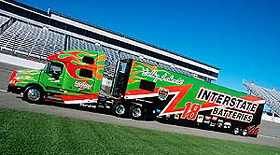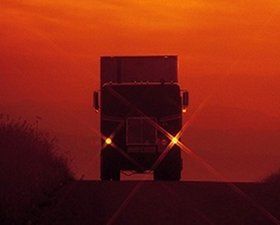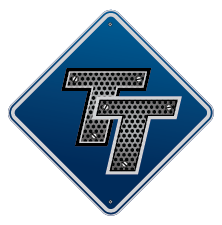Doubles/Triples
Topic 9926 | Page 1
Sue like you I too was worried about hooking up doubles. Then when I started at OD I had no choice but to learn. Let me just say that I worried about it way more than was needed. It's far easier than you would think. Let me give you a break down of how I've been shown.
First thing after you get your assigned trailers go get your dolly. Just bobtail over to it. This one of only two times you have to "manhandle" the dolly. You simply roll the dolly over and connect to the pintle hook. No need to hook anything up yet because your just towing it temporarily. Just make sure the air lines are secure in place so they don't get caught on anything. When wheeling the dolly around by hand it's easiest to do it on level ground or at least on a downhill. Don't try and go up hill. You're just making it harder on yourself. So from here you drive over to your tail trailer. Unhook the dolly and roll it in front of the trailer making sure to line up the fifthwhel to the kingpin. Then leave it. Go hook up to your lead trailer like normal and drive back over to the tail. Now back your trailer as straight as you can to the dolly. Doesn't have to be prefect though. Just gently bump the dolly so you know your far enough back. Get out and hook the dolly back up to the lead. Just the hook part. Now at this point since you've lined up to the kingpin everything should go straight together. Get in and back up to the tail. You'll probably see the tail shift a little as it's getting lined up. After that you just hook your air lines and you're good to go. Well besides pretipping the whole set up and making sure the pintle hook is locked. Some things may change depending on your dolly but the procedure should be about the same. Like I said before it's actually really easy. So don't worry about it.
Bobtail:
"Bobtailing" means you are driving a tractor without a trailer attached.
Doubles:
Refers to pulling two trailers at the same time, otherwise known as "pups" or "pup trailers" because they're only about 28 feet long. However there are some states that allow doubles that are each 48 feet in length.
OWI:
Operating While Intoxicated

Hooking a string(hooking up doubles and triples) are really no different than a 53' in my opinion. It's really easy but has to be done the same way each time.
Don't over think it. You will pick it up in no time.
Doubles:
Refers to pulling two trailers at the same time, otherwise known as "pups" or "pup trailers" because they're only about 28 feet long. However there are some states that allow doubles that are each 48 feet in length.
Thank you so much Heavy and Guy! Yeah I was worrying about it way too much. Now to research some linehaul companies. Should be all the majors here since I'm a skip and a jump from Louisville.
Linehaul:
Linehaul drivers will normally run loads from terminal to terminal for LTL (Less than Truckload) companies.
LTL (Less Than Truckload) carriers will have Linehaul drivers and P&D drivers. The P&D drivers will deliver loads locally from the terminal and pick up loads returning them to the terminal. Linehaul drivers will then run truckloads from terminal to terminal.
Go on YouTube and search "How to hook up a set of Doubles"
There are a bunch of videos. The only difference in the videos is some trucks have Pintle hooks on the tractor and so don't so they use the first lead trailer to pull the dolly to the setup position for the trailers.
Doubles:
Refers to pulling two trailers at the same time, otherwise known as "pups" or "pup trailers" because they're only about 28 feet long. However there are some states that allow doubles that are each 48 feet in length.

Heavy gave you a good snapshot. Physically, you can do it. We have gals at our terminal that are very petite. Also have older men. Remember to lift with your legs, you could easily pull your back or groin muscles if not careful. Never try to stop a rolling dolly.
I have something about hooking doubles in my thread here:
You'll have to weed through the thread to find the part about hooking doubles. I included pictures. It's not exhaustive by any means, but merely a start.
Terminal:
A facility where trucking companies operate out of, or their "home base" if you will. A lot of major companies have multiple terminals around the country which usually consist of the main office building, a drop lot for trailers, and sometimes a repair shop and wash facilities.
LTL:
Less Than Truckload
Refers to carriers that make a lot of smaller pickups and deliveries for multiple customers as opposed to hauling one big load of freight for one customer. This type of hauling is normally done by companies with terminals scattered throughout the country where freight is sorted before being moved on to its destination.
LTL carriers include:
- FedEx Freight
- Con-way
- YRC Freight
- UPS
- Old Dominion
- Estes
- Yellow-Roadway
- ABF Freight
- R+L Carrier
Linehaul:
Linehaul drivers will normally run loads from terminal to terminal for LTL (Less than Truckload) companies.
LTL (Less Than Truckload) carriers will have Linehaul drivers and P&D drivers. The P&D drivers will deliver loads locally from the terminal and pick up loads returning them to the terminal. Linehaul drivers will then run truckloads from terminal to terminal.Doubles:
Refers to pulling two trailers at the same time, otherwise known as "pups" or "pup trailers" because they're only about 28 feet long. However there are some states that allow doubles that are each 48 feet in length.
New Reply:
New! Check out our help videos for a better understanding of our forum features

















Preview:








 TT On Facebook
TT On Facebook
Is it really that physically difficult to hook up a set of doubles? What about that dolly for the 2nd trailer?
Despite the fact that I would prefer to go OTR , my situation is such, I probably should be looking for linehaul or LTL jobs. I'm really wondering about those doubles or tankers and wondering how tough they really can be? Anyone willing to give me more insight? Im not petite.. about 5'9" and reasonably strong and in decent health, but I'll be 53 in a few weeks. Female friendly linehaul companies?
LTL:
Less Than Truckload
Refers to carriers that make a lot of smaller pickups and deliveries for multiple customers as opposed to hauling one big load of freight for one customer. This type of hauling is normally done by companies with terminals scattered throughout the country where freight is sorted before being moved on to its destination.
LTL carriers include:
OTR:
Over The Road
OTR driving normally means you'll be hauling freight to various customers throughout your company's hauling region. It often entails being gone from home for two to three weeks at a time.
Linehaul:
Linehaul drivers will normally run loads from terminal to terminal for LTL (Less than Truckload) companies.
LTL (Less Than Truckload) carriers will have Linehaul drivers and P&D drivers. The P&D drivers will deliver loads locally from the terminal and pick up loads returning them to the terminal. Linehaul drivers will then run truckloads from terminal to terminal.Doubles:
Refers to pulling two trailers at the same time, otherwise known as "pups" or "pup trailers" because they're only about 28 feet long. However there are some states that allow doubles that are each 48 feet in length.
HOS:
Hours Of Service
HOS refers to the logbook hours of service regulations.